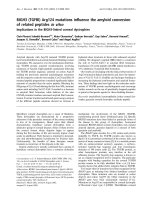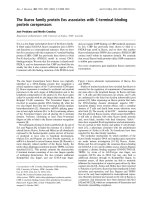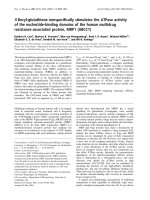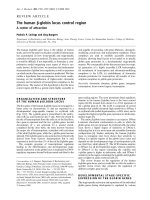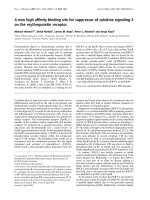Báo cáo y học: "Intraoperative radial nerve injury during coronary artery surgery – report of two cases" pptx
Bạn đang xem bản rút gọn của tài liệu. Xem và tải ngay bản đầy đủ của tài liệu tại đây (207.73 KB, 4 trang )
BioMed Central
Page 1 of 4
(page number not for citation purposes)
Journal of Brachial Plexus and
Peripheral Nerve Injury
Open Access
Case report
Intraoperative radial nerve injury during coronary artery surgery –
report of two cases
Marianna Papadopoulou, Konstantinos Spengos*, Apostolos Papapostolou,
Georgios Tsivgoulis and Nikolaos Karandreas
Address: University of Athens School of Medicine, Department of Neurology, Eginition Hospital, Athens, Greece
Email: Marianna Papadopoulou - ; Konstantinos Spengos* - ;
Apostolos Papapostolou - ; Georgios Tsivgoulis - ; Nikolaos Karandreas -
* Corresponding author
Abstract
Background: Peripheral nerve injury and brachial plexopathy are known, though rare
complications of coronary artery surgery. The ulnar nerve is most frequently affected, whereas
radial nerve lesions are much less common accounting for only 3% of such intraoperative injuries.
Case presentations: Two 52- and 50-year-old men underwent coronary artery surgery. On the
first postoperative day they both complained of wrist drop on the left. Neurological examination
revealed a paresis of the wrist and finger extensor muscles (0/5), and the brachioradialis (4/5) with
hypoaesthesia on the radial aspect of the dorsum of the left hand. Both biceps and triceps reflexes
were normoactive, whereas the brachioradialis reflex was diminished on the left. Muscles
innervated from the median and ulnar nerve, as well as all muscles above the elbow were
unaffected. Electrophysiological studies were performed 3 weeks later, when muscle power of the
affected muscles had already begun to improve. Nerve conduction studies and needle
electromyography revealed a partial conduction block of the radial nerve along the spiral groove,
motor axonal loss distal to the site of the lesion and moderate impairment in recruitment with
fibrillation potentials in radial innervated muscles below the elbow and normal findings in triceps
and deltoid. Electrophysiology data pointed towards a radial nerve injury in the spiral groove. We
assume external compression as the causative factor. The only apparatus attached to the patients'
left upper arm was the sternal retractor, used for dissection of the internal mammary artery. Both
patients were overweight and lying on the operating table for a considerable time might have
caused the compression of their left upper arm on the self retractor's supporting column which
was fixed to the table rail 5 cm above the left elbow joint, in the site where the radial nerve is
directly apposed to the humerus.
Conclusion: Although very uncommon, external compression due to the use of a self retractor
during coronary artery surgery can affect – especially in obese subjects – the radial nerve within
the spiral groove leading to paresis and should therefore be included in the list of possible
mechanisms of radial nerve injury.
Published: 05 December 2006
Journal of Brachial Plexus and Peripheral Nerve Injury 2006, 1:7 doi:10.1186/1749-7221-1-
7
Received: 30 July 2006
Accepted: 05 December 2006
This article is available from: />© 2006 Papadopoulou et al; licensee BioMed Central Ltd.
This is an Open Access article distributed under the terms of the Creative Commons Attribution License ( />),
which permits unrestricted use, distribution, and reproduction in any medium, provided the original work is properly cited.
Journal of Brachial Plexus and Peripheral Nerve Injury 2006, 1:7 />Page 2 of 4
(page number not for citation purposes)
Background
Peripheral nerve injury and brachial plexopathy are
known, though rare complications of coronary artery sur-
gery. The true incidence of nerve injury during general
anesthesia remains unclear and probably is underesti-
mated [1]. The ulnar nerve is most frequently affected
accounting for one third of all nerve damages, whereas
radial nerve lesions are much less common accounting for
only 3% of such intraoperative injuries [2]. We report two
cases of left radial nerve lesion during coronary artery sur-
gery, presumably due to an external compression caused
by a sternal retractor that is used for dissection of the inter-
nal mammary artery.
Case presentations
Case 1
A 52-year old obese man with known ischemic heart dis-
ease but no history of any neurological disease underwent
coronary artery bypass surgery. Preoperative routinely per-
formed diagnostic workup revealed no significant find-
ings. During surgery he was laid supine on the operating
table with both arms fully adducted to his side, fixed in
the neutral position. Intraoperative monitoring included
electrocardiography, pulse oxymetry and automatic blood
pressure monitoring using a standard-size adult cuff
affixed to the patient's right upper arm. No particular
events occurred during anesthesia or surgery and recovery
was good so that patient was transferred within a day from
the intensive care unit to the normal ward.
However, on the first postoperative day he complained of
wrist drop on the left. Neurological examination revealed
a severe decrease in muscle power of the wrist and finger
extensor muscles (0/5 MRC) and a slight brachioradialis
paresis (4/5 MRC) accompanied by hypoaesthesia on the
radial aspect of the dorsum mani. Biceps and triceps
reflexes on the affected left arm were normoactive whereas
the brachioradialis reflex was diminished. All muscles
innervated from the median and ulnar nerve, as well as all
the muscles above the elbow remained unaffected. The
clinical diagnosis of radial nerve injury was set and reha-
bilitation therapy was recommended.
After hospital discharge and about three weeks after sur-
gery the patient was referred for neurophysiological eval-
uation. In the meanwhile the extensor muscles had
already begun to improve. Nerve conduction studies of
both radial nerves were performed using surface elec-
trodes. Compound muscle action potentials (CMAP)
were recorded from the extensor digitorum communis
muscle. The opposite radial nerve was examined for com-
parison. Supramaximal nerve stimulation was achieved
by gradually increasing the stimulation power until the
point where the amplitude of the waveform did no longer
increased was reached. Electrical stimulation at the elbow,
below and above the spiral groove, revealed an amplitude
decline of the CMAP that was indicative of a partial con-
duction block of the left radial nerve along the spiral
groove, whereas CMAP recordings of the right radial nerve
were normal (Table 1). Moreover, motor axonal loss due
to wallerian degeneration distal to the site of the lesion
was suggested by the low distal CMAP. Needle electromy-
ography enhanced this finding by revealing moderate
impairment in recruitment with fibrillation potentials in
radial innervated muscles below the elbow and normal
findings in both triceps and deltoid muscles. The motor
unit potentials were normal, a finding that is consistent
with a recent nerve injury. In conclusion, all electrophysi-
ological findings were indicative of a radial nerve injury in
the spiral groove. The involvement of the brachioradialis
muscle and the fact that both deltoid and triceps muscles
remained unaffected practically excluded the differential
diagnostic alternative of a posterior interosseus neuropa-
thy and a posterior cord brachial plexus lesion respec-
tively.
Case 2
Another 50-year-old obese man was referred for neurolog-
ical and neurophysiological evaluation one month after
having undergone coronary artery bypass surgery. He also
Table 1: Electrophysiological studies performed in both cases on radial nerves bilaterally indicative of a partial conduction block of the
left radial nerve along the spiral groove with additional distal motor axonal loss due to wallerian degeneration.
Examination Left side Right side
Patient 1 Patient 2 Patient 1 Patient 2
CMAP-stimulation at the elbow 5 mV 4.5 mV 7.5 mV 8 mV
CMAP-stimulation below the spiral groove 4.5 mV 4.2 mV 7.2 mV 7.5 mV
CMAP-stimulation above the spiral groove 1.6 mV 1.3 mV 6.8 mV 7.0 mV
SNAP 15 μV8 μV63 μV42 μV
CMAP stands for Compound Muscle Action Potentials.
SNAP stands for Sensory Nerve Action Potentials
Journal of Brachial Plexus and Peripheral Nerve Injury 2006, 1:7 />Page 3 of 4
(page number not for citation purposes)
reported suffering from a left wrist drop since the first
postoperative day. Similarly to the previous case no inci-
dents occurred during anaetshesia and surgery, during
which exactly the same procedures were followed. Electro-
myography and nerve conduction studies were conducted
and revealed identical findings suggestive of an injury of
the left radial nerve in the spiral groove.
Discussion
The similarity of these two cases is impressive. In both
cases, there was no direct injury of the nerve during sur-
gery; no neurotoxic material was injected; no event predis-
posing to nerve palsy (hypotension, hypoxia, electrolyte
disturbances) occurred during or after anesthesia [3]; no
malposition of the left arm on the operating table or later
on the intensive care unit bed that may cause ischemic
nerve injury was documented [4] and no stretch of the
brachial plexus could have occurred [5], since the left arm
was comfortably attached to the patients' body. Predis-
posing conditions such as arthritis or elbow instability
were also excluded [6]. We therefore assume external
compression as the causative factor.
The radial nerve is the largest nerve in the upper extremity,
arising as an extension of the posterior cord of the bra-
chial plexus. In the upper arm lies medially to the
humerus, passes obliquely behind the humerus between
the lateral and medial heads of the triceps and then enters
the spiral groove to exit into the anterior compartment of
the arm piercing the lateral intermuscular septum below
the deltoid insertion. Then the nerve passes through the
radial tunnel and divides into its terminal branches, the
superficial radial, a pure sensory branch and posterior
interosseus nerve, a pure motor branch. The most com-
mon cause of radial nerve injury is compression in the spi-
ral groove which is a shallow groove formed deep to the
lateral head of the triceps, where the nerve lies in close
contact with the humerus. The radial nerve is compressed
most often after piercing the lateral intermuscular liga-
ment, where it lies unprotected by the triceps against the
humerus. Patients with lesions of radial nerve in the spiral
groove need to be differentiated from lesions of the poste-
rior interosseus nerve and of the posterior cord of the bra-
chial plexus. In the first case no sensory deficit is present
and brachioradialis muscle escapes damage. In the second
case, deltoid and triceps muscles are affected. Another dif-
ferential diagnostic alternative that needs to be excluded is
severe C7 and C8 radiculopathy that is characterized by a
different sensory deficit (index, middle, ring and little fin-
ger) and a motor deficit in wrist flexion and forearm pro-
nation as well. In both reported cases clinical and
electrophysiological evidence establishes a radial nerve
injury within the spiral groove. Finally, the differential
diagnostic alternative of cerebral lesion imitating the clin-
ical features of radial nerve palsy needs to be excluded.
However in such a case the weakness is never limited
solely to radial-innervated muscles and generally altera-
tions in muscle tone and in the deep tendon reflexes of the
limb are apparent. Moreover, when a patient with wrist
drop caused by an upper motor neuron lesion grasps an
object, involuntary synkinesis produces wrist extension as
well. Since none of these features were present, central
nervous system affection as cause of both cases of wrist
drop could be clinically excluded.
Assuming an external compression as cause of such a
lesion, we have to consider that the only apparatus
attached to the patients' left upper arm was the sternal
retractor, which is being used for the dissection of the
internal mammary artery. Both patients were overweight
and lying on the operating table for a considerable time
might have caused the compression of their left upper arm
on the self retractor's supporting column which is usually
fixed to the table rail 5 cm above the left elbow joint, in
the site where the radial nerve is unprotected directly
apposed to the humerus.
Similar radial nerve compression has been attributed to
an automatic blood pressure monitoring cuff [7] and a
Kent retractor used for upper abdominal surgery [8]. There
have been only three further reports of radial nerve palsy
due to the use of a self retractor for the dissection of the
left internal mammary artery for coronary artery surgery
[9-11]. Similarly to our cases where symptoms ceased
within two months, in all reported cases the lesion was
reversible.
Transient neurologic symptoms result from action poten-
tial propagation failure caused by ischemia. The most
widely used classification of peripheral nerve injury is the
one introduced by Seddon and Sunderland [12,13]. Focal
pressure, when brief and modest, distorts the myelin pro-
ducing segmental conduction block without wallerian
degeneration. This is termed neurapraxia. With increasing
pressure, the axon is interrupted, resulting in secondary
wallerian degeneration distally. If supporting structures,
e.g. basal lamina and Schwann cells, remain intact this
injury is termed axonotmesis. Severe injury that results in
complete disruption of the nerve and all the supporting
structures is termed neurotmesis. Conduction block is
reversible whereas wallerian degeneration and axonal loss
may have a poorer prognosis with slow and incomplete
recovery [14]. Wallerian degeneration is completed
within 7–10 days. Spontaneous activity, generated by
denervated muscles, appears approximately during the
second week, first proximally and then more distally. It
becomes widespread after the third week and is most
prominent after the fourth week. Thus repeated neuro-
physiological studies are needed to confirm the diagnosis
and follow the process of reinnervation.
Publish with BioMed Central and every
scientist can read your work free of charge
"BioMed Central will be the most significant development for
disseminating the results of biomedical research in our lifetime."
Sir Paul Nurse, Cancer Research UK
Your research papers will be:
available free of charge to the entire biomedical community
peer reviewed and published immediately upon acceptance
cited in PubMed and archived on PubMed Central
yours — you keep the copyright
Submit your manuscript here:
/>BioMedcentral
Journal of Brachial Plexus and Peripheral Nerve Injury 2006, 1:7 />Page 4 of 4
(page number not for citation purposes)
Although very uncommon, external compression due to
the use of a self retractor during coronary artery surgery
can cause – especially in obese subjects – radial nerve
palsy and should probably be included in the list of pos-
sible mechanisms of radial nerve injury. Considering the
small number of reported similar cases and the fact that
symptoms are reversible, it could be assumed that the fre-
quency of such intraoperative complications is probably
underestimated. Prospective studies or even retrospective
evaluation might be helpful in order to estimate the true
incidence of intaoperative nerve injuries, understand the
causative mechanism and eventually find effective pre-
venting strategies.
Competing interests
The author(s) declare that they have no competing inter-
ests.
Authors' contributions
MP performed in both cases the electromyographic stud-
ies in both cases and drafted the manuscript together with
KS, who also made the appropriate literature review. AP
performed the conduction studies whereas GT examined
clinically both patients. NK coordinated the work for this
paper and also helped drafting the manuscript with his
critical remarks. All authors read and approved the final
manuscript.
References
1. Sawyer RJ, Richmond MN, Hickey JD, Jarrratt JA: Peripheral nerve
injuries associated with anaesthesia. Anaesthesia 2000,
55:980-991.
2. Kroll DA, Caplan RA, Posner K, Ward RJ, Cheney FW: Nerve injury
associated with anesthesia. Anesthesiology 1990, 73:202-207.
3. Cheney FW, Domino KB, Caplan RA, Posner KL: Nerve injury
associated with anesthesia. Anesthesiology 1999, 90:1062-1069.
4. Dawson DM, Krarup C: Perioperative nerve lesions. Arch Neurol
1989, 46:1355-1360.
5. Clausen EG: Postoperative anesthetic paralysis of the brachial
plexus. Surgery 1942, 12:933-941.
6. Tuncali BE, Tuncali B, Kuvaki B, Cinar O, Doğan A, Elar Z: Radial
nerve injury after general anaesthesia in the lateral decubi-
tus position. Anaesthesia 2005, 60:602-604.
7. Lin CC, Jawan B, de Villa MV, Chen FC, Liu PP: Blood pressure cuff
compression injury of the radial nerve. J Clin Anesth 2001,
13:306-308.
8. Lee HC, Kim HD, Park WK, Rhee HD, Kim KJ: Radial nerve paral-
ysis due to Kent retractor during upper abdominal opera-
tion. Yonsei Med J 2003, 44:1106-1109.
9. Guzman F, Naik S, Weldon OG, Hilton CJ: Transient radial nerve
injury related to the use of a self retaining retractor for inter-
nal mammary artery dissection. J Cardiovasc Surg 1989,
30:1015-1016.
10. Fernandez de Caleya D, Duarte J, Lozano A, Torrente N: Radial
nerve injury by external compression during the dissection
of the internal mammary artery in coronary surgery. Rev Esp
Anestesiol Reanim 1992, 39:371-373.
11. Briffa NP, Price C, Grotte GJ, Keenan DJ: Radial nerve injury in
patients undergoing coronary artery bypass grafting. Ann
Thorac Surg 1992, 53:1149-1150.
12. Seddon H: Three types of nerve injury.
Brain 1943, 66:237-288.
13. Sunderland S: Nerve injuries and their repair, a critical
appraisal. Edinburgh, Churchill Livingstone; 1991.
14. Fowler TJ, Danta G, Gilliatt RW: Recovery of nerve conduction
after a pneumatic tourniquet: observation on the hint-limb
of the balloon. J Neurol Neurosurg Psychiatry 1972, 35:638-647.

